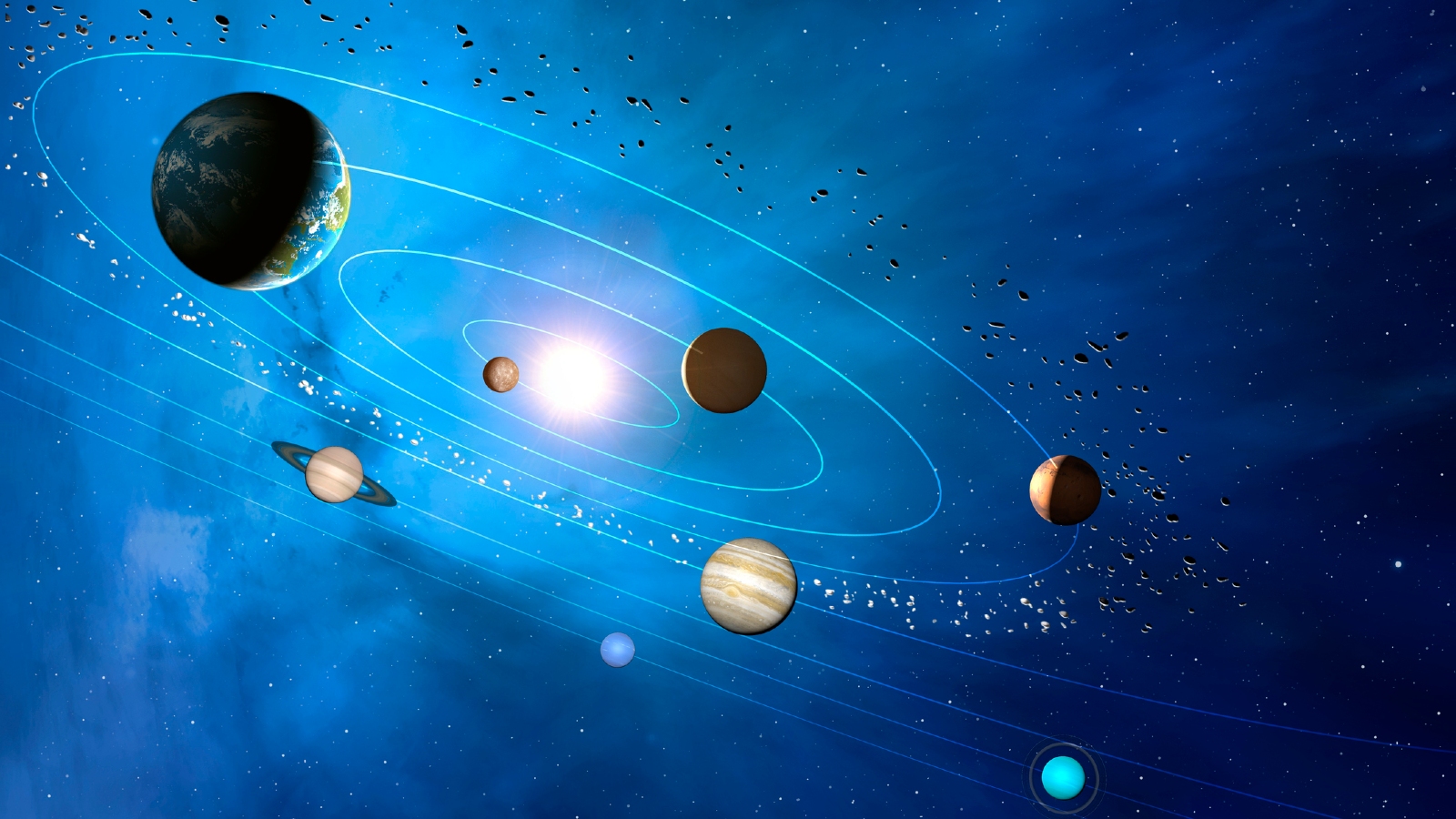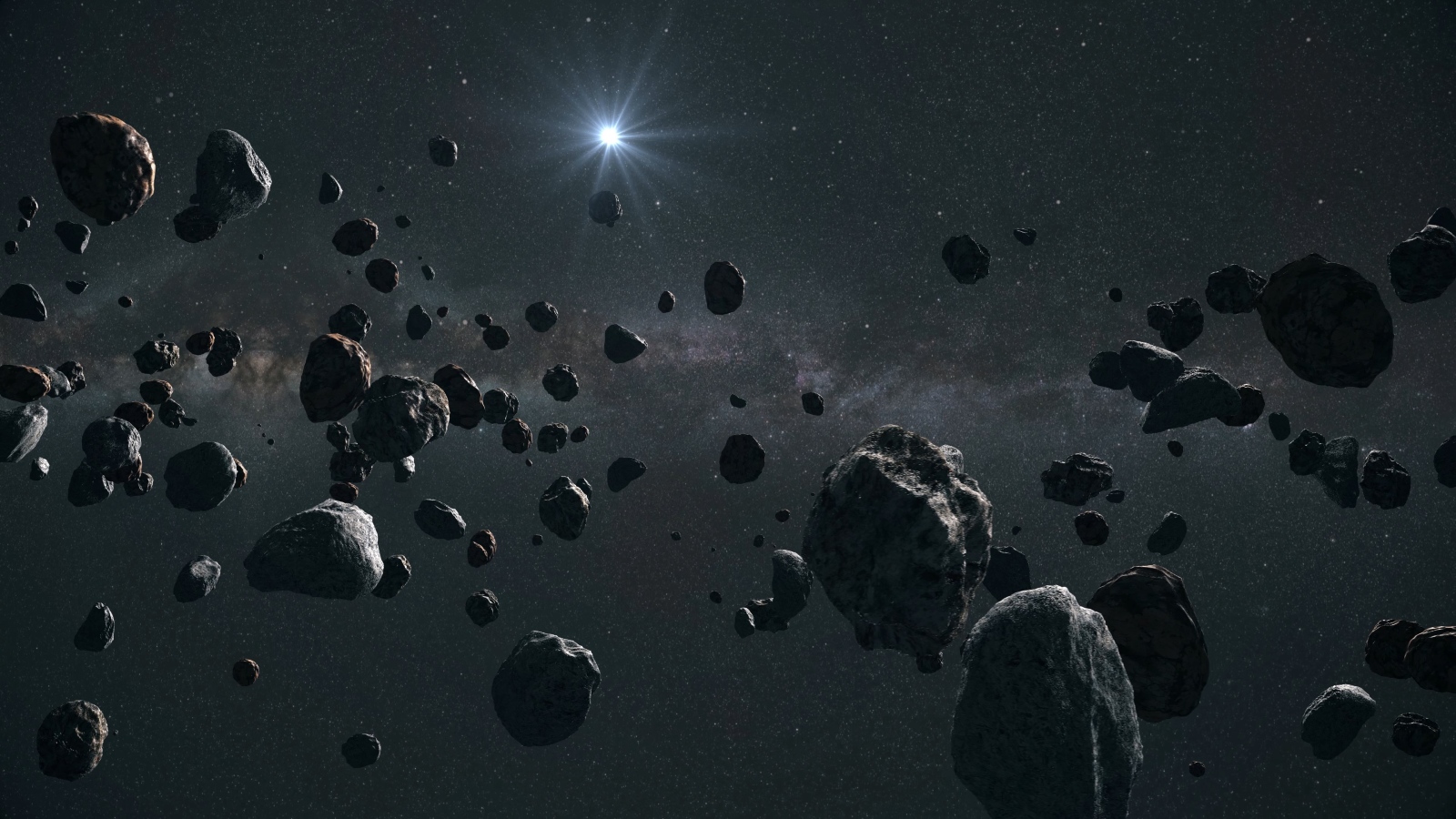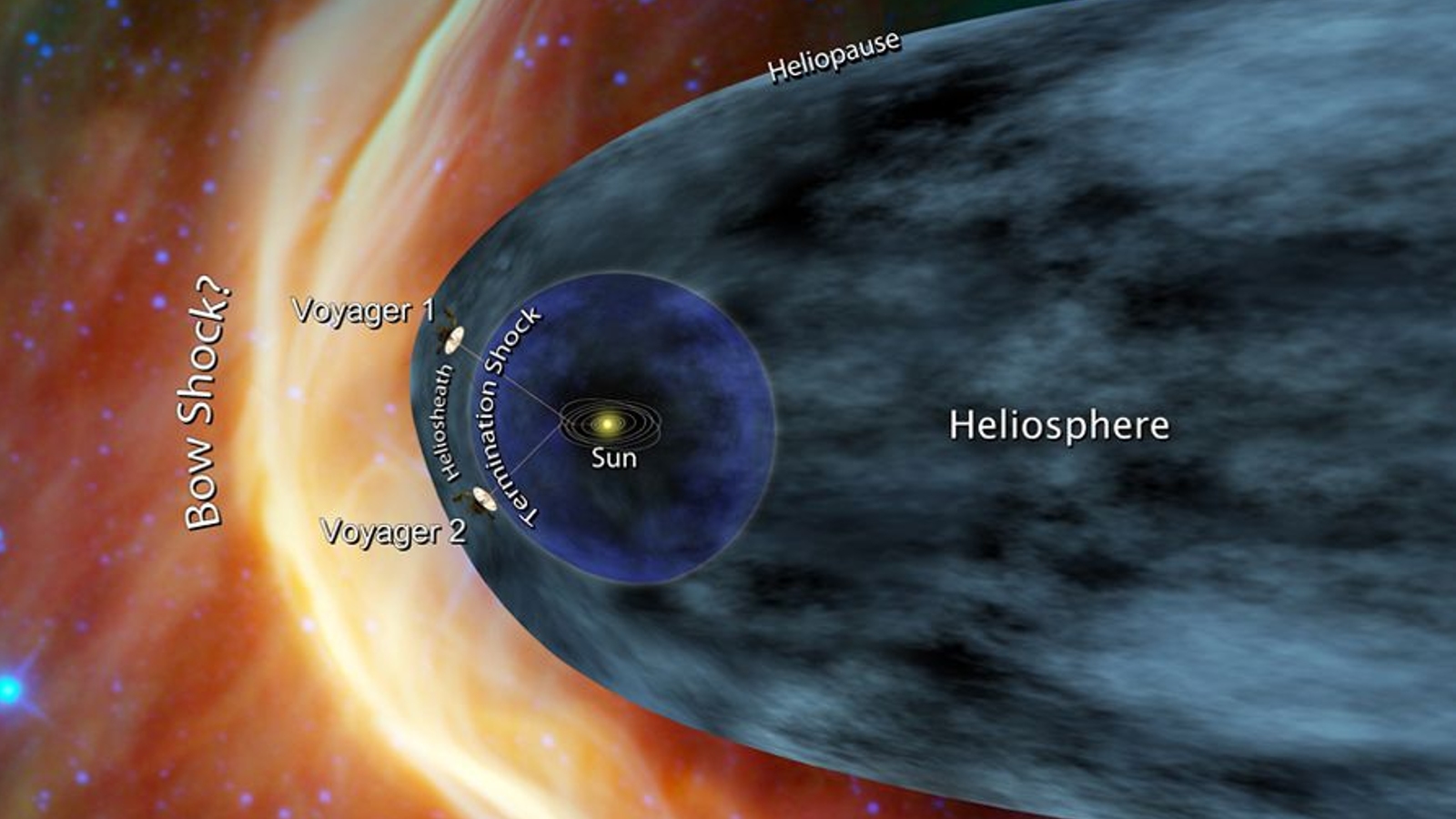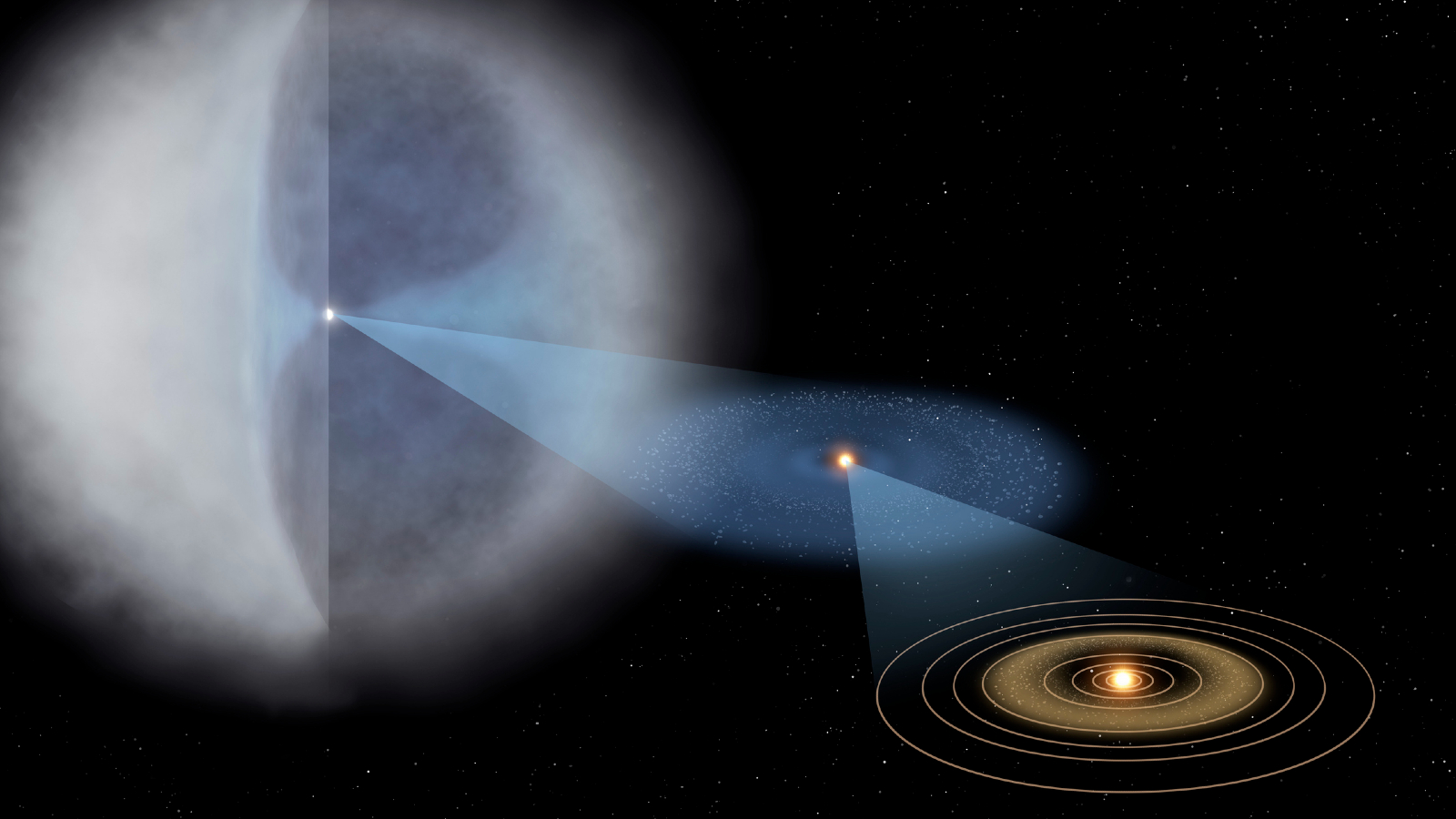Where does the solar system end?
The location of the solar system's outer boundary is a point of contention among astronomers. There are three possible candidates, which "all have merit." But which one is best?

The solar system is an enormous place. Our cosmic neighborhood includes eight planets, around half a dozen dwarf planets, several hundred moons and millions of asteroids and comets, all spinning around the sun — and in many cases each other —at speeds of thousands of miles per hour, like a giant top.
But where does it end? Well, the answer may depend on whom you ask and how they define the solar system.
There are not one, but three potential boundaries to the solar system, according to NASA: the Kuiper Belt, the ring of rocky bodies beyond the orbit of Neptune; the heliopause, the edge of the sun's magnetic field; and the Oort Cloud, a distant reservoir of comets that are barely visible from Earth.
The arguments for each boundary "all have merit," which makes choosing between them complicated, Dan Reisenfeld, a researcher at Los Alamos National Laboratory in New Mexico, told Live Science in an email.
But there is one that most astronomers most commonly agree upon.
Related: Have all 8 planets ever aligned?
Kuiper Belt
The Kuiper Belt stretches between 30 and 50 astronomical units (AU) away from the sun, according to NASA. (One astronomical unit is equal to the distance between Earth and the sun.)
Get the world’s most fascinating discoveries delivered straight to your inbox.
This region is filled with asteroids and dwarf planets, such as Pluto, that have been ejected from the inner solar system by one-sided gravitational tugs-of-war with the planets.
Some astronomers argue that the Kuiper Belt should be considered the edge of the solar system because it loosely represents the edge of where the sun's protoplanetary disk — the swirling ring of gas and dust that later became the planets, moons and asteroids — would have been.
"If one narrowly defines the solar system as just the sun and its planetary bodies, then the edge of the Kuiper Belt can be considered to be the edge of the solar system," Reisenfeld said.
But this definition of the solar system is considered to be far too simple by some astronomers, such as Caltech's Mike Brown.
"It's not really true," Brown told Live Science in an email. "Things have moved around a lot — mostly outward — since the planets were formed." This means the Kuiper Belt does not contain all of the solar system's "stuff," such as the elusive, hypothetical Planet Nine, which (if it exists) likely lies far beyond the Kuiper Belt.
In October 2023, the discovery of a dozen new objects beyond the Kuiper Belt also hinted that there may be a "second Kuiper Belt" lurking even further out.
The uncertainty around this region's own outer edge therefore makes it an unreliable boundary for the solar system as a whole, some researchers argue.
Heliopause
The heliopause is the outer edge of the sun's magnetic influence, known as the heliosphere. At this point, the stream of charged particles emitted by the sun, known as the solar wind, becomes too weak to repel the oncoming stream of radiation from stars and other cosmic entities in the Milky Way.
"Because the plasma inside the heliopause is of solar origin, and the plasma outside the heliopause is of interstellar origin, some people consider the heliopause to be the boundary of the solar system," Reisenfeld said. As a result, the space beyond the heliopause is also often referred to as "interstellar space," or the space between stars, he added.
Two spacecraft have traveled beyond the heliopause: Voyager 1, which made the crossing in 2012, and Voyager 2, which crossed over in 2018. As the Voyager probes crossed the heliopause, they quickly detected changes in the types and levels of magnetism and radiation hitting them, signifying that they had crossed some kind of border, Brown said.
However, despite its name, the heliosphere is not a perfect sphere. Instead, it is more of an oblong blob because most of the interstellar plasma bombarding the solar system hits us from one direction, which creates a bow shock — a rounded shock wave that deflects incoming radiation around the rest of the solar system. The bow shock is located around 120 AU from the sun, and creates a long tail that stretches at least 350 AU from the sun in the opposite direction.
Using the heliopause to delineate the solar system therefore leaves us with a lopsided neighborhood, which goes against some researchers perceptions of planetary systems.
Oort Cloud
The Oort Cloud is the furthest and most expansive potential solar system boundary, extending up to around 100,000 AU from the sun, according to NASA.
"People who define the solar system as everything that is gravitationally bound to the Sun consider the edge of the Oort cloud to be the edge of the solar system," Reisenfeld said.
For some researchers, this is the clear choice for a solar system boundary because in theory, a planetary system consists of all objects orbiting a star.
"I don't understand how anyone considers anything other than the Oort Cloud to be the edge of the solar system," Sean Raymond, an astronomer at the Bordeaux Astrophysics Laboratory in France, told Live Science in an email. "Any other definition seems ludicrous. It is literally the edge of where something can orbit the Sun."
However, other researchers believe that because the Oort Cloud is located in interstellar space, it lies beyond the solar system even if it is bound to our home star.
There is also a large amount of uncertainty about where the Oort Cloud actually ends, which some would argue makes it just as unreliable a border as the Kuiper Belt.
Which boundary is best?
Out of the three possible boundaries, the heliopause is the one that is most often used by researchers, and by NASA, to define the solar system's edge. This is because it is the easiest to pin down and because the magnetic properties on either side of it are significantly different.
"I would argue for the heliopause to be the boundary because it really is a boundary," Reisenfeld said. "Once you've passed it, you know it."
But that doesn't mean that everything beyond the heliopause should be considered an interstellar object, such as the enormous space rock 'Oumuamua, Reisenfeld added. "The Oort Cloud was originally part of the same stuff that the planets were formed from, so it is composed of solar system material, not interstellar material," he said.
But while some researchers are happy to pick a side in this argument, others see no reason why the solar system cannot have multiple boundaries.
"I would say that there is no actual debate," Brown said. "There are just different ways to define it depending on what is important for the question you are trying to answer."

Harry is a U.K.-based senior staff writer at Live Science. He studied marine biology at the University of Exeter before training to become a journalist. He covers a wide range of topics including space exploration, planetary science, space weather, climate change, animal behavior and paleontology. His recent work on the solar maximum won "best space submission" at the 2024 Aerospace Media Awards and was shortlisted in the "top scoop" category at the NCTJ Awards for Excellence in 2023. He also writes Live Science's weekly Earth from space series.




